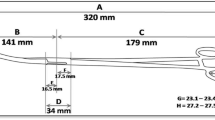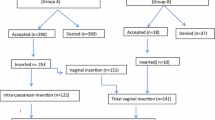Abstract
Background
Ideal time of Intrauterine copper device (IUCD) insertion either to space or limit births in Indian women should be known to check fertility effectively and safely. We therefore aimed to compare various IUCD related clinical factors to assess its acceptability, safety and efficacy in immediate postpartum vaginal insertion, intra-caesarean insertion, delayed postpartum insertion and interval insertion at a tertiary-care centre in India.
Methods
It was a retrospective analysis of prospectively collected data from July 2013 to July 2014. Data was reviewed about maternal age, socioeconomic status, education, occupation and parity of a total of 1631 eligible mothers and was compared between postpartum group and interval group. Data about spontaneous expulsion rate of IUCD, proportion of patients not able to feel thread, reasons for removal and failure rate of IUCD up to a follow-up period of 6 months was also collected in these women and compared among immediate vaginal insertion, intra-caesarean insertion, delayed postpartum insertion and interval insertion.
Results
Majority of women were between 20 and 35 years of age group, literate, multiparous, unemployed and belonged to middle/lower socio-economic strata in both postpartum and interval groups. Spontaneous expulsion rates were 1.84, 0.84, 2.83 and 1.63%; proportions of patients not able to feel thread were 3.07, 8.73, 4.45 and 1.63%; and removal rates were 7.99, 6.48, 7.69 and 3.47% in immediate vaginal, intra-caesarean, delayed postpartum and interval insertion groups, respectively. Failure was seen in only one case of delayed postpartum insertion.
Conclusion
IUCD was more acceptable among young, literate and multiparous women as a contraceptive method. Immediate postpartum period was the safest and most efficacious time for IUCD insertion with least expulsion rate, maximum continuation rate and no failure and, therefore, should be encouraged by adequate counseling of mothers.
Similar content being viewed by others
References
India at Glance—Population census 2011. Census organization of India, 2011. Available from: http://censusindia.gov.in/2011-prov-results/indiaatglance.html. Accessed on 9th June 2017.
International Institute for Population Sciences (IIPS), India. National Family Health Survey (NFHS- 4), 2015–16. Available from: http://rchiips.org/NFHS/pdf/NFHS4/India.pdf. Accessed on 9th June 2017.
Grimes DA, Lopez LM, Schulz KF, Van Vliet HA, Stanwood NL. Immediate post-partum insertion of intrauterine devices. Cochrane Database Syst Rev. 2010;5:CD003036.
Oberoi SS. Updating income ranges for Kuppuswamy’s socio-economic status scale for the year 2014. Indian J Public Health. 2015;59:156–7.
Singh U, Sonkar S, Yadav P, Dayal M, Gupta V, Saxena S. Article comparative evaluation of postpartum IUCD versus interval IUCD at a tertiary care centre in Allahabad, India. Int J Reprod Contracept Obstet Gynecol. 2017;6(4):1534–8.
Jairaj S, Dayyala S. A cross sectional study on acceptibility and Safety of IUCD among postpartum mothers at tertiary care hospital, Telangana. J Clin Diagn Res. 2016;10(1):LC01-4.
Kant S, Archana S, Singh AK, Ahamed F, Haldar P. Acceptance rate, probability of follow-up, and expulsion of postpartum intrauterine contraceptive device offered at two primary health centers, North India. J Family Med Prim Care. 2016;5(4):770–6.
Trussell J. Contraceptive efficacy. In: Hatcher RA, Trussell J, Nelson AL, Cates W, Stewart FH, Kowal D, editors. Contraceptive technology. 19th ed. New York: Ardent Media; 2007. p. 747–826.
Kumar S, Sethi R, Balasubramaniam S, Charurat E, Lalchandani K, Semba R, Sood B. Women’s experience with postpartum intrauterine contraceptive device use in India. Reprod Health. 2014;11:32.
Lucksom PG, Kanungo BK, Sebastian N, Mehrotra R, Pradhan D, Upadhya R. Comparative study of interval versus postpartum Cu-T insertion in a central referral hospital of North East India. Int J Reprod Contracept Obstet Gynecol. 2015;4(1):47–51.
Jain N, Akhtar N. A study to compare the efficacy, safety & outcome of immediate postpartum intrauterine contraceptive device (PPIUCD) with that of delayed insertion. Int J Sci Res. 2015;4(2):1388–91.
Lall J, Nagar O. Comparative study of post placental cut insertion following vaginal and caesarean delivery. Int J Reprod Contracept Obstet Gynecol. 2017;6(3):901–6.
Bhutta SZ, Butt IJ, Bano K. Insertion of intrauterine contraceptive device at caesarean section. J Coll Phys Surg Pak. 2011;21(9):527–30.
Mohan H, Ramappa R, Sandesh M, Akash BK. PPIUCD versus interval IUCD (380a) insertion: a comparative study in a referral hospital of Karnataka, India. Int J Reprod Contracept Obstet Gynecol. 2015;4(6):1730–2.
Srivastava S, Bano I, Ishrat N. Evaluation of PPIUCD versus Interval IUCD Insertion. Int J Sci Res. 2016;5(7):1780–2.
Singal S, Bharti R, Dewan R, Divya, Dabral A, Batra A, Sharma M, Mittal P. Clinical Outcome of postplacental copper T 380A insertion in women delivering by caesarean section. J Clin Diagn Res. 2014;8(9):OC01–4.
Gupta A, Verma A, Chauhan J. Evaluation of PPIUCD versus Interval IUCD (380A) insertion in a teaching hospital of Western U. P. Int J Reprod Contracept. Obstet Gynecol. 2013;2(2):204–8.
Author information
Authors and Affiliations
Corresponding author
Ethics declarations
Conflict of interest
The authors declare that they have no conflict of interest.
Ethical Approval
For this type of study formal consent is not required.
Additional information
This work was performed at the Maulana Azad Medical College and Associated Lok Nayak Hospital, New Delhi, India.
Dr. Purnima Gupta is a Senior Resident in Department of Obstetrics and Gynaecology at Gandhi Medical College and Associated Sultania Zanana Hospital, Bhopal. Madhavi Mathur Gupta is a Professor in Department of Obstetrics and Gynaecology at Maulana Azad Medical College and Associated Lok Nayak Hospital, New Delhi. Rachna Sharma is a Senior Specialist in Department of Obstetrics and Gynaecology at Maulana Azad Medical College and Associated Lok Nayak Hospital, New Delhi.
Rights and permissions
About this article
Cite this article
Gupta, P., Gupta, M.M. & Sharma, R. Intrauterine Copper Device (CuT380A) as a Contraceptive Method in the Indian Context: Acceptability, Safety and Efficacy Depending on the Timing of Insertion. J Obstet Gynecol India 68, 129–135 (2018). https://doi.org/10.1007/s13224-017-1079-z
Received:
Accepted:
Published:
Issue Date:
DOI: https://doi.org/10.1007/s13224-017-1079-z




